
Our little ones surprise us every day with their newfound skills and insight, so could time telling be your child’s undiscovered superpower?
Being able to tell the time on an analogue clock remains a fundamental skill that every child is encouraged to learn, but it is fast becoming a struggle for today’s pupils. Most UK children have no experience using an analogue clock before encountering one in school as we live in an increasingly digital world that relies heavily on devices to tell us the time. This means that many children are no longer developing the skills needed to read one and are missing out on the numerous benefits of mastering telling time from an early age.
From increased independence to improved social skills, time telling is a key skill that prepares children for primary school and beyond, so let’s explore the advantages of teaching your little one to tell the time before they start school.
1. Improve organisation
It’s easy for little ones to lose track of time, particularly if they cannot yet tell the time by themselves, but being disorganised can quickly cause them lots of stress and hassle.
For example, if they’ve promised to clean their toys away before a certain time, then they may become panicked when they realise they don’t have much time left to complete the task. Then, without the relevant time telling skills, they may be unable to break this task down further into manageable tasks e.g. ‘five minutes to put away the teddies’ or ‘two minutes to put my book back on the shelf’.
Once they have a good understanding of time management and are able to apply it to their own lives, you’ll find that they are keen to keep track of the time. You might even find that the responsibility for managing their time-sensitive activities is no longer yours, at least during playtime!
2. Reduce stress and worry
These early years organisational skills will also reduce the stress and anxiety that young children feel when trying to keep track of their own schedules. Even though it is a parent’s responsibility to manage their child’s daily schedule, and the teachers’ responsibility to manage their timetable at school or nursery, children like to be kept informed of their planned activities.
Being able to read a clock will mean that they no longer have to worry about being late or constantly ask you what time it is, as they will be able to read this information for themselves. This new skill will also help them to know how much time is left of a particular activity and will help them to feel in control of their day, as it won’t come as a surprise to them when they have to stop what they’re doing and move on to the next activity.
3. Boost confidence
If your little one struggles with their confidence, then learning how to tell the time is a great way to build up their confidence in themselves and their abilities.
Our simple time-teaching method shows children how to read a clock in 2 or 3 easy steps, and they can take as long as they need to learn this new skill. Once you have shown them how to use our method on a clock they will be able to practice their new skills as many times as they like without any fear of failure. This no-consequence approach to learning will continue to develop their skills and develop their self-confidence, particularly once they are able to demonstrate their abilities to others.
Make sure you remind them often how impressive it is that they have mastered this new skill all by themselves and ask family members to do so as well. Positive reinforcement and encouragement are vital for a child’s development, and it will encourage them to share their abilities with others in the future with confidence.
4. Foster social skills
Being able to tell the time by themselves allows young children to navigate social situations that require an awareness of time, whether this is at home, at school, or in the community.
Whilst it is largely on parents to arrange meet-ups between young children and to make sure that they arrive on time, little ones can also take some responsibility by getting themselves dressed and ready to go. Understanding time also encourages them to respect others’ time and helps them to understand that it is bad manners to be late or to get the time wrong when visiting their friends.
Whether they’re meeting a friend by the school gates at a certain time or letting another child know that it is nearly time to return to the classroom after lunch, being punctual will encourage other children to see your little one as a reliable, considerate friend. Knowing the structure of their daily activities will also reduce their own anxiety in social settings and will allow them to focus entirely upon making friends and developing their social skills, rather than worrying about how much longer is left of a particular activity.
5. Introduce mathematical concepts
Finally, having even basic time telling skills will help your little one once they start school, as this provides a solid foundation for their learning that they can now build upon in class.
Time is a gateway into the world of mathematics and being able to read a clock is a great introduction to the mathematical concepts that your little one will need to grasp as part of their primary school journey. Every EasyRead clock clearly details the 60 minutes of each hour and the 12 hours of the daily cycle, so teaching them how to tell the time at a young age gives them the opportunity to familiarise themselves with large numbers before they encounter them in school. These can also easily be transferred into basic mathematical ones such as addition and subtraction, as they can use the clock to add and subtract e.g. ‘25 minus 20 is 5’.
Starting school with a basic understanding of numbers (or an advanced understanding of their times tables, depending upon how quickly they learn!), will help your child feel confident in the classroom from the get-go. They will be able to answer questions that other children may not know the answers to yet, participate in group learning activities, or simply feel less overwhelmed thanks to their educational head start.
Supporting parents and children in telling time
Ready to start your child on their time telling journey?
Our EasyRead methods were designed to make it as easy as possible for young children to learn how to tell the time and can be used on any product from our range. So, familiarise yourself with our time telling methods today and click here to find all the resources you need to support their learning.

In the UK, children learn how to tell the time in school from the age of 5, but that doesn’t mean you can’t give them a helping hand before then! In fact, many children start asking questions about the passage of time and how we understand it from a very young age, and their understanding develops throughout early childhood as they explore the world around them. So, help your little one to develop a proactive understanding of the concept of time and support their ongoing learning with these helpful tips.
Apply it to their lives
At this young age, the concept of time is very abstract for most children as it involves thinking about events that haven’t happened yet, or may not happen, as well as events that occurred before they were born. In a general sense, children may remember past events and understand important events that are yet to happen, but their memory capabilities are still developing and they will struggle to conceptualise how much time has passed or how much time is left of any particular period of time.
So, the first step in introducing this complex concept to young children is to make it tangible and apply it to their everyday experiences. One of the best ways to do this is by adhering to their natural sleep-wake cycle (or circadian rhythm) which allows the implementation of a steady sleep schedule. Whilst your little ones will know that they are tired, they might not register that this happens at a particular time every day, so make this more obvious for them by using clear signals to show that it is night time. Dim the lights, quiet household noises, and avoid any exciting activities in the hour before bedtime, and show that this isn’t just happening for them by pointing out that everyone else is also winding down for the night and getting ready to end the day.
Explore the seasons
Once your little one has an awareness of the days passing, it’s time to encourage them to see the passage of time on a larger scale by helping them to observe it in the world around them. Just as they fall asleep at night and wake up in the morning, so do the green leaves of summer become orange in the autumn and fall in the winter before returning next spring in a consistent cycle.
This reframes the passing of time from being all about minutes and hours to months and years, although this can be quite hard for children to grasp unless they observe it for themselves. So, rather than using a calendar to explain these larger units of time, take your little one out for regular walks to observe the seasonal changes together. Point out the cold air and snow in winter and the warmth of summer to tie their understanding in with sensory signals and make the learning process a fun, engaging activity that you share together.
Follow a routine
Now that they have a general understanding of the concept of time, both in their own lives and in the world around them, it’s time to start teaching them to track it for themselves.
Explain to them that rather than just being divided into night and day, each day is further broken up into morning, afternoon, and evening, as well as hours, minutes and seconds within this. Sit down with them and draw up a chart of their daily activities in the order that they occur, starting with waking up and brushing their teeth and ending with saying goodnight to everyone and reading a story together before bed. Write the time of each activity next to it and as they grow, they’ll be able to point to these times on a clock and tell you how much time is left before a parent returns from work, before you all have dinner, and before they go to bed.
After your child has familiarised themself with this passage of time laid down on paper, you can then extend the activity to include their weekly routine to show that some activities happen on a weekly, or even monthly basis, rather than just daily. Tick the days off a calendar for a month before turning it over and showing that the natural cycle of time is ongoing, and that being able to track the passing time is a key skill for any developing mind to learn.
Consistency is key
When introducing young children to the concept of time, consistency is essential. Whatever time-teaching activities you choose, make sure that you make them a regular part of your child’s routine to help them fully grasp the concept and encourage daily practice. You can ask them how long an activity should take for example, such as brushing their teeth (2 minutes) or getting dressed in the morning (10 minutes), as these activities should take the same amount of time each day. It might take a while for them to build up their confidence when giving an answer, but with enough practice and repetition they will know exactly how long 10 minutes should feel when performing a task.
Similarly, that consistency needs to come from you, so be aware of how you yourself talk about time. For example, don’t just say that you’ll be there to help them with a particular task in ‘just a moment!’ if you are likely to be much longer, as this can be confusing for little ones who are still learning about the different measurements of time.
Explore our EasyRead range
Finally, once the time comes for your child to learn how to tell the time on a clock, our range will have everything you need to give them plenty of practice at home and out and about.
- Our EasyRead wall clocks: Add one of our educational clocks to your child’s bedroom or playroom wall and ask them plenty of times a day to read the time using either the 12/24 Hour or the Past & To method.
- Our EasyRead alarm clocks: Our alarm clocks display the time with silent sweeping movements so there’s no annoying ticking keeping your little one awake – just an LED nightlight and a glowing clock face in the morning to make it easy for them to read the time whenever they need to.
- Our EasyRead watches: Give your little one the tools to tell the time for themselves and practice their new skills no matter where they are with our EasyRead watches.
If you need any more information on how to use our EasyRead products or about our time-teaching method, find out everything you need to know here.
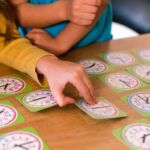
The chilly winter evenings and dark weekends mean less opportunities for outside play but the perfect reason to spend time together inside as a family! So, if you’re keen to make the most of this extra time, why not take this opportunity to make learning how to tell the time fun for your little ones?
From our free downloadable resources to our Countdown to Christmas games, we’ve put together a guide on how to make learning fun this winter, so, gather the rest of the family and take a look!
How to tell the time
Did you know that most clocks and watches only display about 20% of the information that we need to read the time? This means that 80% of the information is missing, making it hard for young children to understand what number each hand is pointing to. On top of this, children often struggle to decide which hand is which, as most clocks have hour and minute hands that are the same length.
In 1992, we decided that children were not receiving the support that they needed to read a clock as there was nothing on the market that specifically addressed these difficulties. This is why we started EasyRead Time Teacher, and also why we developed our simple time-teaching method that explains how to tell the time in 2, or 3, easy steps.
Our method is designed for children of all ages, and works on both 12/24 hour clocks and Past & To clocks, depending on which model your children prefer. So, explore our full method by clicking here, and then read on to discover how you can make this learning process fun and engaging with our favourite time-teaching activities.
How to make it fun!
Now we move on to the exciting part! Our simple process can be used on any EasyRead products from our range, so let’s take a look at what time teaching activities are available to support your child’s learning.
1. Tell the Time Card Games
If you’re wondering how to keep the kids entertained on a rainy winter afternoon, our Tell the Time cards offer hours of fun playing all the family favourite games.
Available in two levels – suitable for ages 5-7 and ages 8-11 – each pack contains 60 cards showing 15 different times that can be used to play all kinds of games. From snap and matching pairs, to buddy-up and bingo, the aim of every game is to match up the times and recognise the different minutes and hours of the day whilst having fun.
2. TwinTime Cards
Another time-teaching game that is popular with children (and adults!) of all ages are our TwinTime cards. Sold individually or in boxes of 10, our cards feature a printed EasyRead clock and moveable hands that let you display any time of the day for a simple learning exercise that also lets you count backwards and forwards, in 5s and 10s, and practice fractions.
3. EasyRead Watches
Don’t keep our EasyRead watches hidden away under the tree until Christmas Day – these brilliant time-teaching tools can get a lot of use in the run-up to Christmas.
If your child has one, or if you’re planning to gift them one, encourage them to use it by asking them how long a particular task will take. You can ask them to make a note of what time they start an activity like brushing their teeth or cleaning their room, and then again when they stop, before asking them to work out how much time they have spent on that task.
This is a great way to add some excitement to the dull daily tasks and to make the most of the exciting festive activities like putting up the tree or baking some Christmas treats.
4. Time Charts
Creating a time chart showing your childs’ daily schedule is a great way to help reinforce the importance of knowing how to tell time in our everyday lives.
Get your little one to create a chart showing what time of day they are expected to wake up, brush their teeth, go to school, and go to sleep, and keep it fun by encouraging them to add their favourite activities in as well such as an after-school club or time with family. This is also a good way to maintain a sense of structure in their daily lives during the holidays and particularly in the run up to Christmas when all sense of time seems to go out the window!
5. Downloadable Resources
Finally, if your budget is a little tight this winter, our free resources are available to print or download on our website. From our Make a Clock activities to our Home Education Day Planner, we have an entire webpage dedicated to keeping your little ones entertained for less, so click here to view our free resources today.
Learning how to tell time with EasyRead
If you’re hoping to make learning how to tell the time as fun and engaging as you can for your kids this winter, our time-teaching method is the first place you should start! Check it out now and get started on planning your engaging activities today.
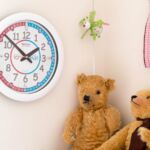
Is your child struggling to contextualise the passage of time on a clock? Understanding this concept can be tricky for young children – particularly if they are unable to see the process’ relevance in the wider world. So, if you are looking for ways to help them grasp this concept and enjoy a fun activity together this summer, learning how to tell the time without a clock is a great way to teach your child about time.
Using the sun’s position
First up: using the sun’s position to work out what time it is. As we all know, the movement of the sun across the sky is actually caused by the movement of the Earth as we orbit the sun, and this daily orbit gives us a good idea of the time at different points in the day.
To get started, take your little one outside in the morning, whilst the sun is still rising in the East. Once they have found the suns’ place in the sky, explain to them that the sun will always be visible in the East before midday, and that if they’re ever stuck without a clock, then they will be able to estimate the time of day by finding the sun’s place in the sky.
At midday, take them outside once again and explain to them that the sun will always be directly overhead at midday, and then finally take them outside again as the sun sets in the West. To conclude the day, explain how, thanks to the rotation and orbit of the Earth, the sun has followed a consistent journey across the sky, and that we are able to estimate what time it is by tracking its movement at different times of the day. This hands-on method helps children to better understand how time follows a consistent pattern and its connection to the Earth’s movements, giving them a tangible representation of time that they will always be able to refer back to.
Making a sundial
Once your child has developed a basic understanding of the sun’s relevance in time-telling activities, you can begin to build upon this understanding by making a sundial. Summertime is the best time to create a sundial as you will have more hours of sunlight to work with, so before your little one wakes up, head out to the garden and find a sunny spot to place a stick upright in the ground. This stick will function as a time telling device, as its shadow length and position will change as the sun’s position changes, making it a great demonstration for any curious child wondering how to tell the time without a clock.
When your child joins you in the garden to begin the activity, mark where the sticks’ first shadow falls with a stone or some colourful chalk. Then make sure that you return to mark the new shadows position at regular intervals throughout the day to create your child’s very own sundial, and make sure that you emphasise to your child that the passage of time is being clearly demonstrated by these markers.
Tracking the North Star
Tracking the North Star is a fascinating way for parents and children of all ages to explore the passage of time by working together to chart the celestial movements. Whilst this concept may seem too challenging for younger children, it follows a similar method to the sundial activity – only this time, we can clearly see that we are the moving object in the night sky.
Start by locating the North Star, also known as Polaris, in the night sky on a warm, clear evening. The North Star is a bright star that remains nearly fixed in the same spot in the night sky whilst the other stars appear to rotate around it due to Earth’s rotation. Point its position out to your child and take a few minutes every hour or so over the next few hours to relocate the star and observe how the surrounding stars appear to change position as the Earth continues to rotate.
Don’t forget to remind your little one that this apparent movement reflects the Earth’s rotation and the passing hours, rather than the movement of the stars, as younger children can become confused if this is not routinely explained to them. Through these observations, children will be able to clearly see the steady, predictable patterns of the night sky and develop their awareness of times’ broader context, as even the stars follow the rules of time every night.
Moon phases
There are two particular ways to use the moon to track the time, and one is best completed over the course of several weeks. However, the less time-consuming activity can be done by tracking the moon’s course over a single night, so if you are planning to do this, start off by noting the time at sunset. If the moon is already visible during this time, then make sure your child clearly notes the moon’s position in the sky as the sun sets.
Over the course of the night the moon will appear to move across the sky as both the Earth and the moon rotate, so regroup once an hour until bedtime to observe the moons’ new position at different times. By comparing the moon’s position to the time of sunset, you can calculate an approximate time based on its position earlier on in the evening.
If you are looking to track the position of the moon across a longer period of time, then engaging your little one in a charting activity is a great way to keep them engaged over the holidays. Begin by observing the moon every night and noting its shape and position, and keep a moon journal to record the moon’s shape each night by shading in the shape. Explain to your child how the moon’s appearance changes due to its orbit around Earth and the varying angles of sunlight hitting its surface to help them grasp longer time periods beyond the daily cycle. Over the course of approximately 29.5 days, the moon goes through its phases: new moon, first quarter, full moon, and last quarter, and by tracking the moon’s phases children are able to see a clear, repetitive system that spans weeks and months.
How to tell the time without a clock
Whilst all of these activities are great opportunities to deepen your little ones’ understanding, it is also clear that the easiest way to tell the time is with an EasyRead clock or watch! As we enjoy watching the movement of the moon, stars, and our own planet through the skies, let’s take a minute to be grateful that our daily routines no longer require us to know how to tell the time without a clock – and that we instead have access to all the time-telling resources that we need.
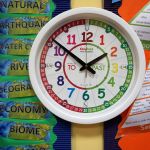
If your syllabus for the new year includes teaching your pupils to tell time, or you are keen to hone their new skills in 2024, then make sure that your classroom is equipped with our classroom clocks and teaching resources. Designed with functionality and accessibility in mind, our clocks are the perfect tool for teaching young children how to apply their new skills and knowledge. Featuring clear, easy-to-read designs and robust structures to withstand the wear and tear of a busy classroom, these clocks are specifically designed as a visual aid to help pupils grasp the concept of telling time, so make time teaching a group effort this new year with our essential teaching clocks.
The importance of the right classroom clock
The right clock for a classroom plays a vital role in teaching children how to read the time and in creating a learning environment. They serve as a visual aid that helps pupils understand the concepts of minutes, hours, and seconds, as well as the relationship between these three and how this creates the passage of time. By having a teach the time clock prominently displayed in a classroom, pupils are able to practise reading and interpreting time in a real-life context, as well as develop core life skills.
Classroom clocks promote time management skills. By having a clock displayed prominently in the classroom, pupils develop a sense of time awareness, and learn how to allocate and manage their time effectively whilst completing a task, meeting deadlines, or remaining punctual to lessons. Clocks also help to create a structured learning environment, as teachers can use them to establish a clear routine that pupils are expected to understand and follow. This includes clearly showing the time left for a specific task or lesson, helping to keep the class on track and minimise disruptions, as well as reduce the number of questions around the time or how long is left in a lesson.
By having an easy-to-read clock prominently displayed, pupils are able to practise reading and interpreting time in a real-life context, so read on to explore the unrivalled benefits offered by our specialist range of clocks.
EasyRead Classroom Clock
Our EasyRead Clocks are designed specifically for classrooms, as their clear, large design makes them visible from all areas of the classroom and ensures that all pupils, regardless of their seating position, can easily access the time.
The simple and engaging design of our clocks is perfect for nursery and primary school classrooms, as well as those who are just starting to learn about the time, as a hands-on teaching aid that introduces the concept of time. Depending upon the preferred method of your school or pupils, your clock can show either the “12/24 Hour” method or the “Past & To” method, as each design has been specially made to make it easy for children to learn to read the time. This simple teaching system contains all the relevant scaffolding that a child needs to confidently recognise numbers, identify the hour and minute hands, and piece together the method to reveal the correct time, and is a great way to start your class on the time-telling elements of the school curriculum. To help with this, the curriculum notes are printed on the back, providing you with a handy reference while teaching, and the hanger makes it easy to securely rehang the clock after a demonstration.
Our specially designed school clocks are made to save time and reduce frustration for pupils and teachers alike, as well as helping pupils build confidence in their own abilities. By hanging one of our specialist clocks in your classroom, you can eliminate the need for pupils to constantly ask you to tell them the time. So, with our clocks, you and your colleagues can focus on teaching, knowing that you have a reliable and effective tool to support your teaching and reinforce your lessons on time.
EasyRead Playground Clocks
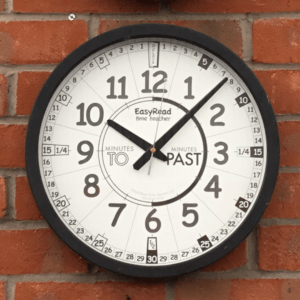
The design of these clocks is the same as the rest of our range, including the option to choose either the “Past & To” or “12/24 Hour” method, depending upon the time format taught by your schools’ curriculum. This standardised design allows for a continuation of the pupils’ learning across indoor and outdoor spaces, reinforcing what they have learnt and offering them the ability to read the time themselves, no matter where they are.
With their battery-operated mechanism and robust designs, our playground clocks are built to withstand the elements throughout the school year. The weatherproof powder-coated steel frame and toughened glass lens protects the face from any potential damage, and means that these clocks will continue to function come rain or shine, providing a reliable and accurate time display for your pupils. So, whether these weather-proof clocks are installed in the playground, entrance ways, school garden, or onsite sports facilities, teachers and pupils alike can incorporate time-telling challenges into various outdoor activities, so add one of our clocks to your outdoor space and watch as learning and fun blend seamlessly together.
Other teaching tools and educational activities
To further enhance student learning, our range can be easily combined with our range of educational resources for a streamlined, standardised approach, and additional learning opportunities for pupils. Here at EasyRead Time Teacher, we offer a range of resources that complement the methods used by our clocks, including:
⦁ Tell the Time Cards: These cards are designed to work in conjunction with a school clock to enhance the learning experience and allow pupils to practise telling time through engaging games. These cards feature 15 different times of the day, and pupils of all ages can use these educational resources to play a range of games, including snap, matching pairs, buddy-up, and bingo, to practise their new skills and reinforce their understanding of time in a fun and engaging way.
⦁ TwinTime Cards: The twintime cards are a particularly useful interactive learning resource, as they allow pupils to compare and contrast different times, further developing their understanding of the passage of time. They are a hands-on learning tool that have been specifically designed for primary school children to work through time-related activities and challenges, by adjusting the moveable hands to visualise the relationship between the big and small hands.
⦁ EasyRead Classroom Set: For teachers who want a comprehensive set of teaching resources, the EasyRead Classroom Set is the perfect choice. This set includes an EasyRead clock, tell the time cards, and twintime cards, equipping your classroom with everything you need to create a dynamic and interactive learning environment.
By integrating our clocks with these additional teaching resources, visual aids, and interactive activities, teachers across the country can prepare their classrooms for a year of hands-on learning and ensure that their pupils have access to the resources they need to reinforce their understanding of time.
Enhancing student learning with the right classroom clock from EasyRead Time Teacher
Teaching pupils to read the time is an essential skill, and our classroom resources and clocks are on-hand to support your pupils and maximise their learning. These resources are designed with accessibility and functionality in mind, featuring clear, easy-to-read designs and robust structures that can withstand the demands of a busy classroom, so be sure to promote a multi-faceted approach to learning in 2024 and give your pupils the opportunity to reinforce their learning with our full range of classroom clocks and teaching resources.

Are you struggling to support and encourage your child who can’t tell time? From the ages of 6 and 7, your child will be taught this life skill in schools, but if your little one is struggling or falling behind, then don’t worry – whilst this is likely a source of worry for your family, teaching children to independently read the time is often a challenging task and will probably require the use of additional resources and extra support. That’s why, at EasyRead Time Teacher, we are dedicated to making learning how to tell the time an accessible and engaging experience for any child or adult who can’t tell time. From engaging aids, to our EasyRead clocks, our resources and interactive tools make learning a fun and engaging experience and support parents and children alike to become confident in telling time.
The struggle of telling time
Learning how to read and understand the time is a crucial skill for any young child’s development. Not only is it important for their syllabus and academic development, but it also helps them understand the concept of the passing of time, manage their daily routines, and develop a sense of responsibility. However, some children may find it challenging to grasp this concept, leading to frustration, a sense of falling behind their peers, and concerns around their own capabilities. If your child can’t tell time or is struggling, then it’s important to identify the signs early on and understand the common reasons behind their difficulties.
The most obvious sign that your child is struggling with telling the time is their inability to read analogue clocks or understand the relationship between the hour and minute hands. For young children, many of the challenges come from low level confusion that arises in the moment, rather than a deep-rooted confusion around the passage of time and the overwhelming responsibility of learning to track this passage. However, if your child’s confusion comes from being unable to understand the relationship between numbers and time, or struggling with concepts like half past, quarter past, and quarter to, then their learning will greatly benefit from the inclusion of resources, games, or real-life examples into their daily routine. Additionally, if your child is consistently late or struggles to manage their personal time effectively, it could be an indication that they need additional support to develop their understanding of time.
Supportive strategies to help your child
If your child is having trouble developing this life skill, don’t worry – these difficulties are much more common than many parents realise, and there are several strategies you can employ to support their learning and help them become confident in this essential skill:
1. Use visual aids and resources: Visual aids, such as our EasyRead clocks, provide a tangible representation of time and make it easier for children to understand the relationship between the hour and minute hands. Our clocks and resources feature colour-coded circles for the different hands and clear labels for the 12/24 hour and past and to methods, making it easier for children to break down the overwhelming concept of time into smaller, actionable steps that make it easier to interpret the time.
2. Create a daily routine: Establishing a consistent daily routine is a quick and accessible way to help children develop their understanding of time progression and how it relates to their daily activities. Set regular times for meals, bedtime, and activities, and involve your child in following the schedule by encouraging them to remind you of the time, or by regularly asking them what time they perform a specific task and how much time they have left before then.
3. Break it down: Time is an overwhelming concept for small children, especially when faced with analogue clocks and complex concepts. In order to break down the learning process into smaller, manageable steps, start by teaching them to identify the hours, then move on to the half-hour, quarter-hour, and so on, backed up by consistently asking them to practise telling you the time. Gradually introduce more complex concepts as they become comfortable with the basics, including switching to the 12/24 hour method or introducing a digital clock.
4. Make it fun: Learning should be an enjoyable experience for children, particularly when learning an important skill that they will need to use for the rest of their lives. Incorporating games, activities, and resources into their time-telling practice will help your child come to see time as a puzzle to be solved, or an engaging activity, rather than a complex or overwhelming task, and will develop a positive relationship with managing their own time.
By employing these supportive strategies, you can help your child overcome their difficulties and develop a solid foundation in reading and understanding time. If you’re interested in exploring key educational resources to boost their understanding and practise reading the time, explore our recommendations below.
⦁ Using clocks for teaching and practising
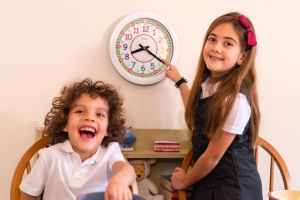
Analogue and EasyRead clocks are invaluable tools when teaching children to understand and practise their time telling abilities. They provide a clear and easy-to-read display of the time, down to the minute, making it simpler for children to identify the current time quickly and with minimal confusion. Introducing clocks throughout your home creates a learning environment in which your child is constantly exposed to time-telling opportunities, without becoming overwhelmed by these new concepts, so here are some of our key recommendations.
- EasyRead Wall Clock: Hang this wall clock in your child’s bedroom or in their play area for the ideal introduction to reading the time. With their clear, easy-to-read designs and silent operation, our colourful clocks use either the past & to or 12/24 hour teaching methods and are perfect for the whole family to use to support your little ones’ time-telling skills.
- EasyRead Alarm Clock: Our alarm clocks feature a large, clear display with a simple design, silent sweeping movements, and an LED nightlight for a discreet and useful addition to your child’s bedside. They’re perfect for teaching children the basics of time-telling and means that they are able to read their clock if they wake up in the middle of the night, or if they wake up before it is time to get out of bed. They also feature a crescendo alarm and a built-in light sensor that matches the brightness of the room according to your child’s preferences.
- EasyRead Wrist Watch: A wristwatch is a portable and practical way for your child to practise reading the time on their own terms throughout the day. With their clear, colour-coded dials and simple teaching method, our watches make it easy for children to practise their time-telling abilities wherever they go, making it the ideal first watch for children aged 4 and above.
By incorporating our clocks into your home decor and your child’s daily routine, you can create a supportive environment for your child to practise and reinforce their time-telling skills.
⦁ Using games to practise and reinforce time-telling skills
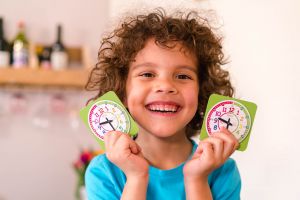
Learning to read a clock doesn’t have to be a tedious task, particularly if your child is struggling more than their peers or is becoming overwhelmed by having to practise a skill that they don’t yet fully understand. To combat this, there are numerous fun activities and games you can incorporate into your child’s learning that will not only engage them, but also provide opportunities for them to practise and reinforce their time-telling capabilities whilst playing with friends or family.
If this sounds like the best course of action for you to take with your child who can’t tell time, then here is a rundown of our recommended activities and games from our range:
- Tell the Time Cards: Our cards feature engaging, interactive designs that support children to practise reading and interpreting the time at home. Our easy-to-use cards feature different times of the day and can be played in various ways, such as snap, matching pairs, buddy-up, and bingo, and are designed to cater to the abilities and needs of different age groups, ensuring that children of all ages can engage and learn at their own pace.
- TwinTime Cards: Our TwinTime Cards offer a unique and hands-on approach to interactive time telling practice. With a Past & To dial on one side and a 24-hour time dial on the other, our double-sided cards allow children to independently move the hands to display different times, and then quiz family members or friends on the displayed time. This game enhances children’s understanding of both methods of reading a clock and encourages critical thinking, but also supports other skills like counting forwards and backwards, learning fractions, and counting in 5s and 10s.
By incorporating these activities and games into your child’s learning routine, you can make the time-telling process an enjoyable and interactive experience.
⦁ Collaborative learning

Working with your child’s teacher to support their learning and develop a coordinated approach to practising is a proactive way to ensure your child has all the support and resources that they need. Teachers have access to various resources and strategies that can complement your efforts at home, including playground clocks and classroom sets, so, take the time to discuss your child’s struggles with their teacher and work together to identify the best strategies and resources to support their learning. This collaboration between home and school will provide your child with a well-rounded and consistent approach to learning this important life skill, giving them the best possible opportunity to overcome their struggles.
Celebrating your child’s progress with EasyRead Time Teacher
Teaching and supporting your child may present challenges, but with patience, support, and the right resources, they can develop this essential skill. If your child currently can’t tell time, then be sure to celebrate their progress, no matter how small, and continue to utilise our range of resources and aids to make the learning process engaging and enjoyable for both you and your child.
Explore our full range today, and equip your child with the resources and confidence they need to develop valuable time-management skills that will benefit them throughout their lives.

It has been recently revealed that many primary school children are behind in terms of maths ability and learning, with young children often being weeks behind pre-lockdown norms. So, what can we do to support teachers and children in the classroom? Our innovative and effective time teaching resources are specifically designed to engage and empower students and support their maths learning. We aim to make the learning process both enjoyable and easy-to-understand, and with our comprehensive collection of materials, primary school children can easily explore important maths concepts and develop a clear understanding of maths. From interactive games and worksheets to engaging activities and real-life examples, our time teaching resources provide a well-rounded approach to maths learning, so read on to explore our time teaching resources.
The Importance of Maths
A good, working understanding of key mathematical concepts, and their relevance to day-to-day life is a crucial aspect of a child’s education. This understanding is not just important for academic success and basic addition – it also helps them develop problem-solving skills and enhances their critical thinking abilities. From managing finances to interpreting data, maths is an integral part of everyday life, and it is essential for children to have a solid understanding of maths from an early age.
From a young age, children are exposed to numbers and basic mathematical concepts, such as telling the time – but as they progress through primary school, the complexity of maths increases and it becomes necessary to provide them with additional tools, resources, and clear demonstrations to support their learning. However, since the outbreak of the Coronavirus and the subsequent lockdowns, children of all ages have not had access to the hands-on learning process, and the resources that they need to develop their maths abilities.
The COVID-19 pandemic has disrupted education in various ways, and one of the areas that has been the most affected is maths learning. A recent report by the Education Policy Institute has highlighted how much primary school pupils are struggling with maths post-COVID. The report reveals a growing mathematical skills gap in the wake of the pandemic, with primary school children being 5 weeks behind in their learning when compared to expectations prior to the outbreak.
This report, hailed as a ‘wakeup call’ for politicians and policymakers alike, demonstrates that education recovery after the pandemic is not achieving the results that it needs to ensure every child is learning at the required level. The lack of in-person interaction over lockdown has greatly impacted this, as maths often requires hands-on activities and collaborative learning, and the absence of regular classroom routines and face-to-face teaching has made it difficult for children to grasp new concepts and receive immediate feedback. Finally, even if all of these factors weren’t an issue, many children lacked access to technology or struggled with the transition to virtual learning environments, putting them at even more of a disadvantage.
How Our Time Teaching Resources Can Help
At EasyRead, we understand the importance of providing effective tools to support maths learning, particularly with the nationwide push to get primary school learning back on track.
Our time teaching resources are designed to engage students and facilitate their understanding of important mathematical concepts. With a range of interactive games, worksheets, activities, and real-life examples, our resources offer a comprehensive approach to teaching maths. So, let’s explore our range of time teaching resources.
EasyRead Classroom Clocks
One of our key time teaching resources is the EasyRead Classroom Clock. This specially designed clock incorporates unique features that make it easier for children to learn and understand the concept of time, including:
⦁ A large, clear face that divides the hour into simple segments, allowing children to easily distinguish between minutes and hours.
⦁ The minute hand is longer and thinner, while the hour hand is shorter and thicker, and both hands move within a clearly designated ring, making it easy for children to read the time accurately.
⦁ Available with either the 12/24 Hour or Past & Two teaching method, depending upon the requirements of each school.
By using the Easy Read clock in the classroom, teachers can actively engage students in learning about time. The clock’s design encourages hands-on interaction and enables children to practise reading analogue time independently, as well as making it much easier for them to confidently recognise numbers. This resource not only enhances their mathematical skills but also cultivates a sense of time management and punctuality, and helps pupils to apply their new skills to their day to day lives by using the clock to observe the passage of time during a lesson or to see for themselves how much time is left until the end of the day.
EasyRead TwinTime Cards
In addition to the classroom clock, our EasyRead TwinTime Cards provide another valuable resource for supporting maths learning. These cards feature a unique double-sided design that allows children to practise both analogue and digital time and helps them make connections between the two.
By using these cards in the classroom, teachers can create engaging activities and games that promote active participation and consolidate pupils’ understanding of time. Either use the cards with the classroom clock, or Teacher Cards, by asking them to write the time down on their cards, or pair the pupils up and encourage them to interact with each other and support each other’s learning through play.
Our cards are also excellent for introducing further mathematical concepts, such as addition, subtraction, and fractions: simply use our cards to count forwards and backwards from 30, count in multiples of 5s and 10s, and discuss how the clock face can be divided into fractions in the form of half an hour, a quarter of an hour, and 10 minutes.
EasyRead Tell the Time Card Games
Our Tell the Time Cards build upon the skills learnt through our clocks and games, and focus in more detail on specific time concepts, such as quarter past, half past, and quarter to the hour.
Each card presents a visual representation of the time, allowing children to practise reading and interpreting different times through familiar games such as snap, matching pairs, buddy-up, and bingo. By incorporating these cards into classroom activities, teachers can create hands-on opportunities for students to explore different time scenarios and strengthen their time-telling skills.
Easy Read Classroom Sets
To provide a comprehensive maths learning experience, we also offer EasyRead Classroom Sets. These sets include a combination of classroom clocks, TwinTime cards, and tell the time cards, providing teachers with a complete toolkit for supporting students’ mathematical development.
By using the classroom sets, teachers can create a dynamic learning environment that caters to different learning styles and abilities. The combination of visual and interactive resources in the sets ensures that all children have access to effective tools for understanding and mastering time concepts, and creates a collaborative learning environment for all pupils to develop their own skills and support their classmates.
Choosing the Right Time Teaching Resources
Selecting the right time teaching resources for your students is crucial to their maths learning journey. When choosing from our range of resources, it is essential to consider the specific needs and abilities of your students by assessing their current level of understanding and identifying any areas where they require additional support. This is more important than ever in light of the recent reporting around the current mathematical skills gap in UK primary schools.
If your students are just beginning to learn about time, then our Classroom Clock is an excellent introduction to telling time. The clock provides a visual and interactive approach to time learning, and is always available on the wall for pupils to engage with and practise their new skills.
Once the students have built up a familiarity with the core concept of time and a basic understanding of how to tell time on their own, then our cards are an excellent way to consolidate their skills. They are also an excellent choice for students who are more advanced and need reinforcement in specific time concepts, and cater to different learning styles and abilities, ensuring that every student has the opportunity to succeed in learning how to tell the time.
Supporting Pupils and Teachers with Our Time Teaching Resources
The challenges in maths learning post-COVID highlight the need for effective resources to support students in their mathematical development, and our time teaching resources offer a range of innovative and engaging materials designed to create a comprehensive approach to teaching and learning.
Explore our full range today to find the perfect resources to bridge the gap in maths ability and promote a hands-on approach to telling time in your classroom.
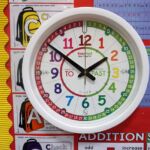
As the new term gets underway, we have been taking a look at some of the teachers who have been making good use of our time teaching clocks and classroom resources. All of our products are designed to support teachers with practical, specialist resources, and encourage children to enhance their learning with engaging activities and accessible resources. But don’t just take our word for it: join us as we shine the spotlight on our full range of classroom clocks and resources.
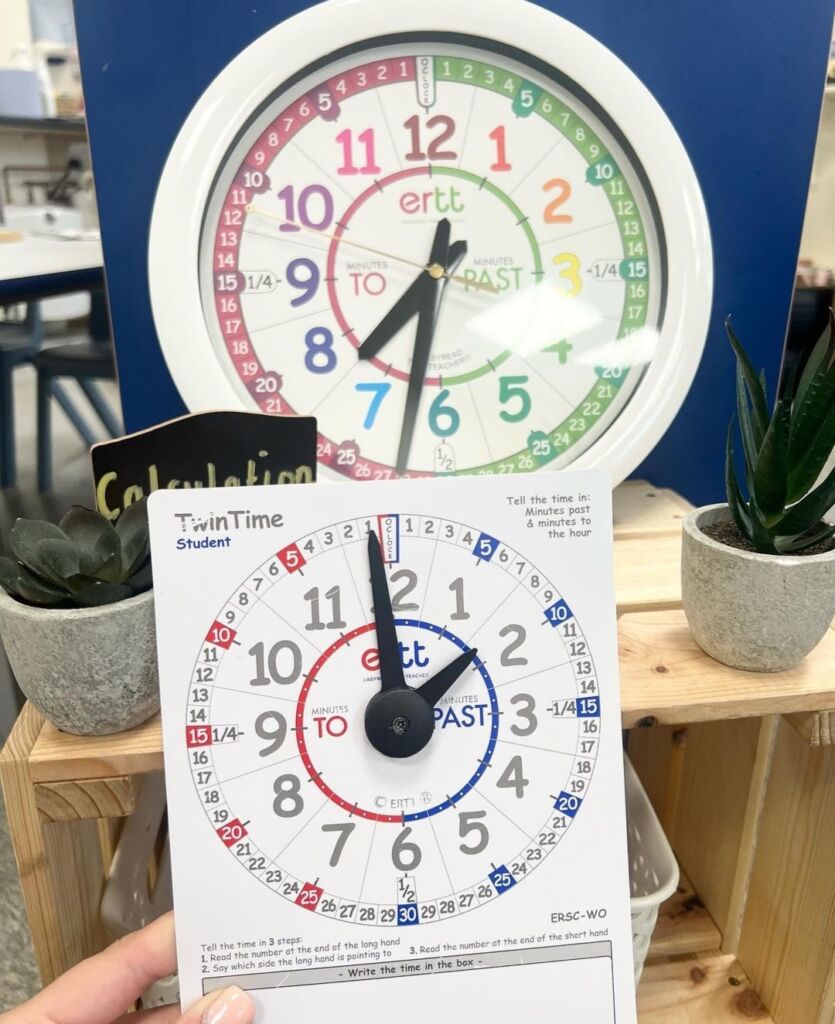
“Telling the time is a fundamental skill, and it’s so important to get the teaching of time right (..) I can’t wait to teach time, so I can use some of the great resources provided by EasyReadTimeTeacher. I can’t wait to have a time monitor, so that the children can all have a turn wearing the watch. I think they will love using it to tell the time.”
@ misscsclassroom92
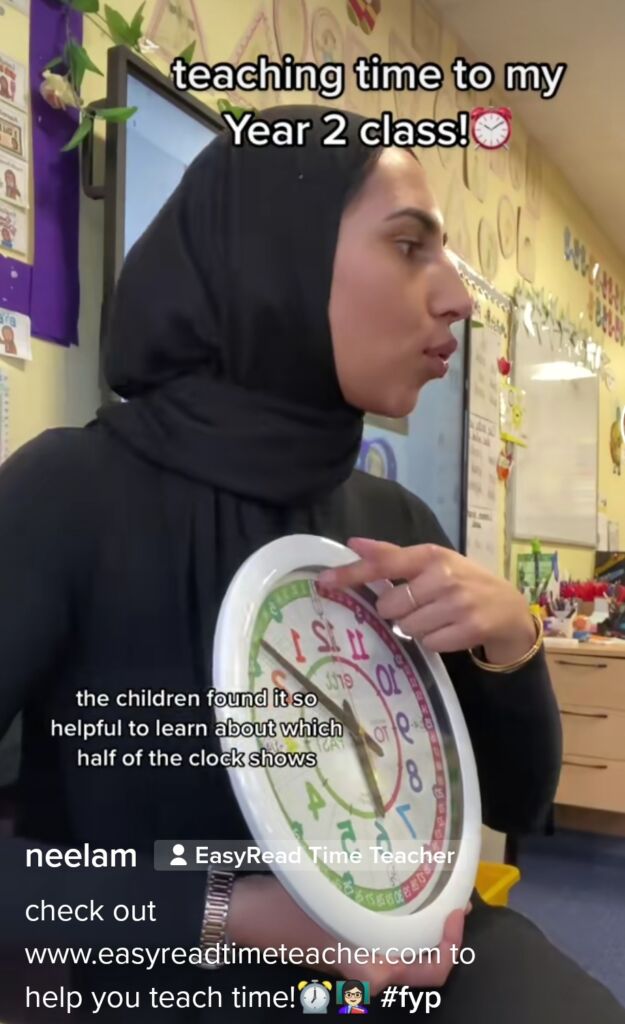
“The children found it so helpful to learn about which half of the clock shows past and quarter, including all the different intervals, because it is colour-coded! They also have these really cool children’s watches, which have the exact same face as the teaching clock, so I will definitely be putting this up in my classroom!”
@ nrashid_x
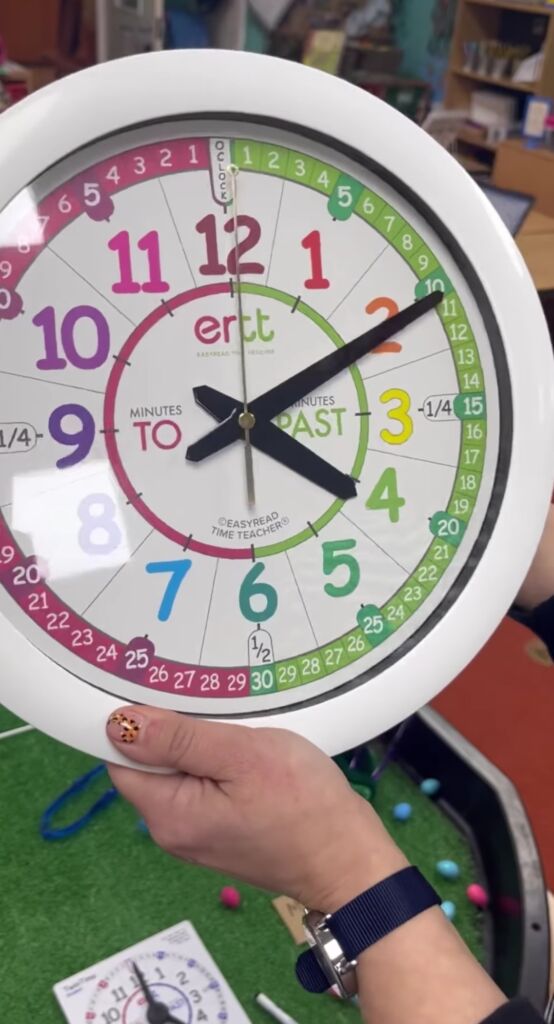
“@easyreadtimeteacher has got you sorted with their incredible telling the time bundle. (..) I love how bright and colourful these products are and know they will be a super addition to our time teaching. I know they will especially love wearing the watch! For those working in older year groups, the breakdown of minutes is so helpful as it’s so visual for the learner.
@ missbeyfs
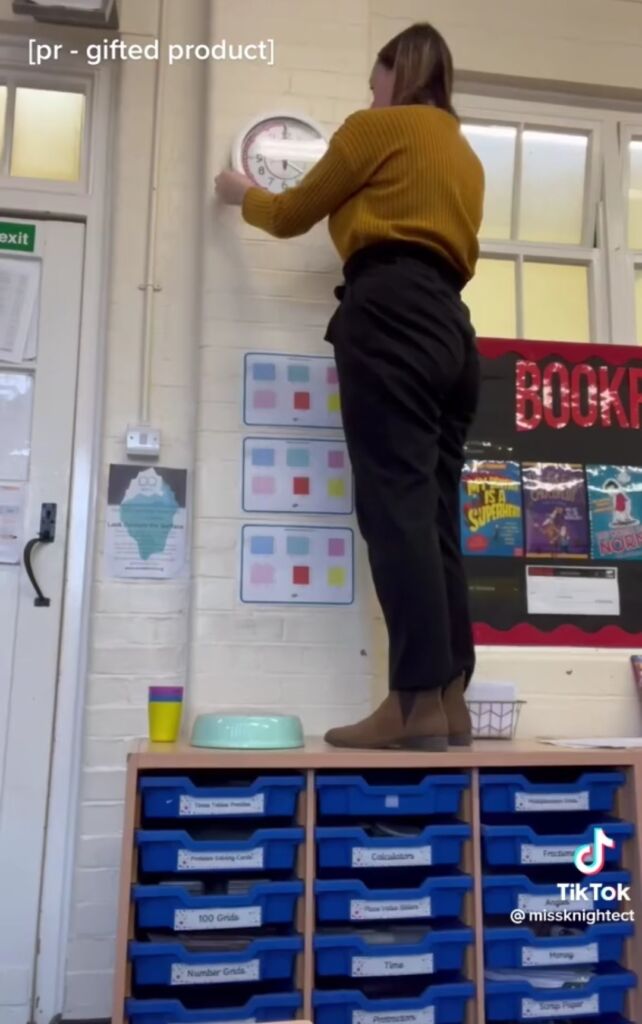
“Telling the time is obviously such a key foundational maths skill, but also one that is really tricky. But thanks to Easy Read Time Teachers’ range of products it has become so much easier. I wish I had discovered these products when I was teaching time a few months ago but I will definitely be using them next time around. Nevertheless, I’m hoping that this clock will now stop my class from asking what time it is and how long until lunchtime!”
@ missknightect
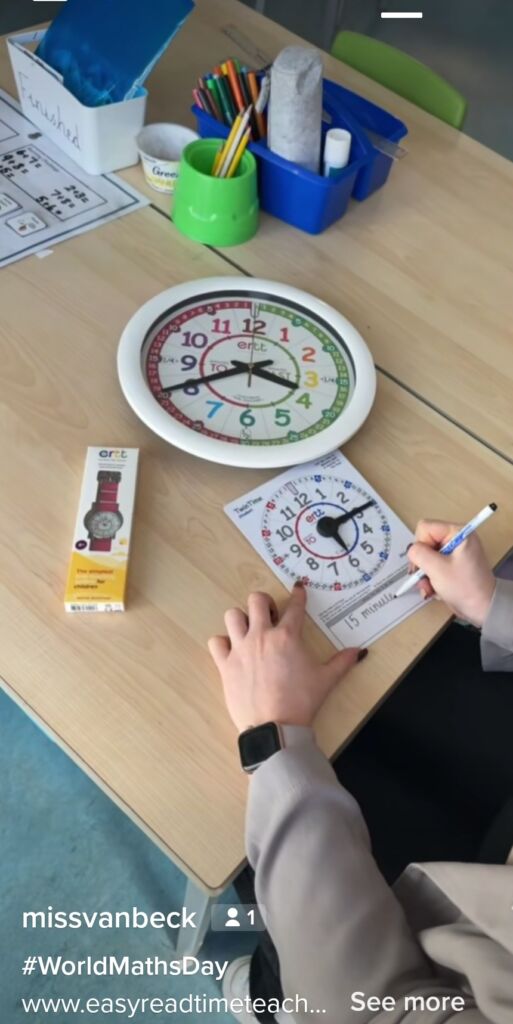
“Easy Read Time Teacher has this amazing wall clock which I just absolutely love: it splits up the concept of time really simply and it’s a great visual for children to use. And I just love the student teaching aid that they can write on with whiteboard pens. I love the durability of this and it’s great for working through problems with children one-to-one.”
@ missvanbeck
Our Classroom Resources
Making a real difference has always been our key aim here at Easy Read Time Teacher, and we are delighted to see that our time-teaching products are supporting learning in schools across the country. If you are searching for high-quality time teaching clocks, then explore our full range today and find the perfect resources for your class.

As students up and down the country return to school after Easter, now is the perfect time to stock up on the latest and best teaching materials for your classroom. As an educator, you know how important it is to have the right tools to help your students learn and stay on track, and with a variety of specialist designs and colours to choose from, our teaching time clocks are perfect for any classroom or teaching style. Our classroom resources, including playground clocks and card game resources, are perfect for daily use in a classroom and ensure that you have a consistent approach to teaching time. So, get ready for the new term with confidence and ease, and let our range of time-teaching products do the hard work for you.
Time Teaching Clocks
If you are planning on introducing your pupils to the concept of time this term, or building on their existing time-telling skills, then our time teaching clocks are an excellent resource for your classroom wall. Our clocks are specially designed to contain all the information that a child needs to learn how to tell the time, with easy-to-read numbers and colour-coded segments to ensure every student can access the resource from any part of the room.
View our full range of teaching time clocks here.

“The children found it so helpful to learn about which half of the clock shows past and quarter, including all the different intervals, because it is colour-coded! They also have these really cool children’s watches, which have the exact same face as the teaching clock, so I will definitely be putting this up in my classroom!”
@ nrashid_x
Twin Time Cards
Our TwinTime Student Cards offer an excellent and engaging opportunity for pupils to practise telling the time. Each card can be used individually, for a more formal test, or in groups to encourage pupils to support each other and are also an effective resource for introducing students to elements of the primary school numeracy curriculum. The cards are designed to be durable and long-lasting, as well as easy to maintain, with a high-gloss, write-on wipe-off PVC sheet, and ample room for the students to fill in the time displayed on the clock.
View our TwinTime Student Cards here.

“Easy Read Time Teacher has this amazing wall clock which I just absolutely love: it splits up the concept of time really simply and it’s a great visual for children to use. And I just love the student teaching aid that they can write on with whiteboard pens. I love the durability of this and it’s great for working through problems with children one-to-one.”
@ missvanbeck
Watches
Our EasyRead wrist watches come with the same clear face designs and teaching methods as our clocks, for a consistent and comprehensive approach to teaching time. Whilst many of your pupils will no doubt already have their own watches, having a designated classroom watch offers many opportunities for pupils to practise their time-telling abilities. For example, the pupils can take it in turns to be the class Time Monitor, who keeps track of their daily routine, or who the other students can ask to tell them the time, creating an engaging and practical time-telling environment that encourages all pupils to participate.

“Telling the time is a fundamental skill, and it’s so important to get the teaching of time right (..) I can’t wait to teach time, so I can use some of the great resources provided by EasyReadTimeTeacher. I can’t wait to have a time monitor, so that the children can all have a turn wearing the watch. I think they will love using it to tell the time.”
@ misscsclassroom92
Playground Clocks
Our range of Playground Clocks feature similar face designs to our classroom clocks and watches, reinforcing their learning with uniform designs that contain all the information they need to practise telling the time during breaks. The durable and reliable weatherproof clock can be used anywhere in the school, including outdoor spaces such as playgrounds, gardens and school entrances. The powder-coated steel frame with toughened glass ensures durability and longevity and is designed to withstand harsh weather conditions, making our playground clocks a worthwhile investment in your students as they learn to tell the time themselves.
Stock up on Classroom Resources for this term
Now is the perfect time to stock up on the latest and best classroom resources for your class. Our range of classroom resources, including clocks and card games, are perfect for daily use in a classroom and ensure that you have a consistent approach to teaching time.
Find the right resource for your pupils and your classroom, or explore our range of resources for use at home, in our full range of time teaching products.
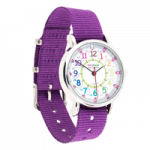
EasyRead Time Teacher watches are a fantastic present to give to the important child in your life.
Our clocks and watches are a brilliant and educational gift for the little ones in your family. Children all over the world have loved taking ownership of their learning – it’s great to see children teaching themselves and having fun doing it. Every child has to learn how to tell the time as part of their Key Stage 1 Maths syllabus, so why not give them a helping hand with one of our wristwatches?
They’re comfortable and colourful, with a large clear face that shows children everything they need to know to tell the time. The wristband will fit even the tiniest wrist and it’s removable so it can be washed.
Click here to see our EasyRead watches.
With an EasyRead watch, a five year old can learn to tell the time in just 10 minutes. Click here to see what our customers say.
Don’t worry, our 3-step process is very easy to master and our free resources are just a click away. We have all the support you need.
In addition, we also offer clocks for the home. Our 3-step teaching system is easy to master, enabling the children to learn with very minimal input from the adults around them. Click here to view our EasyRead clocks.


















